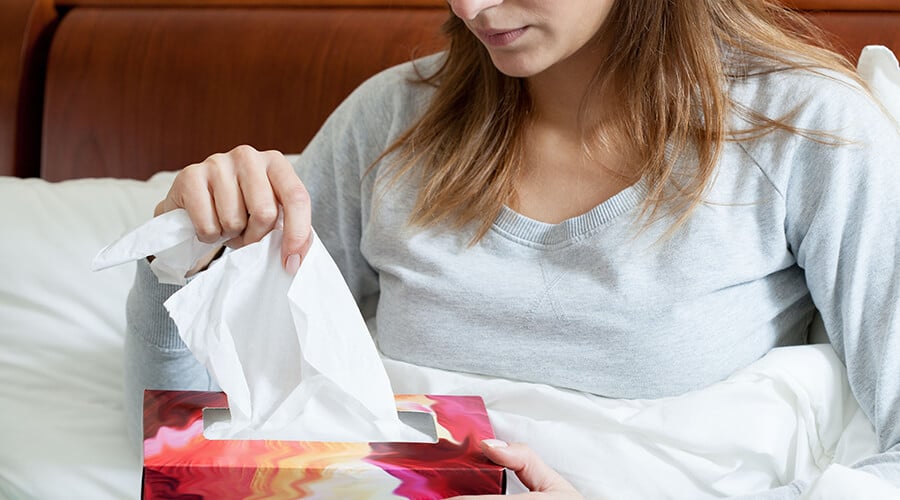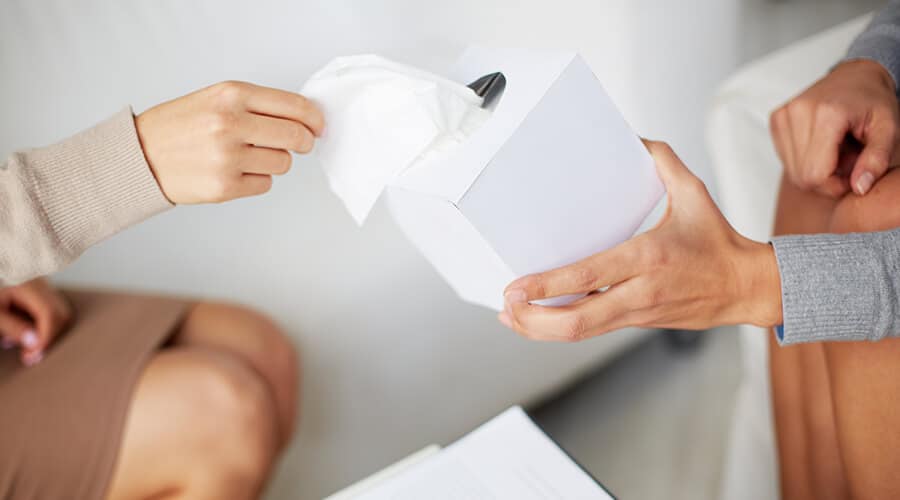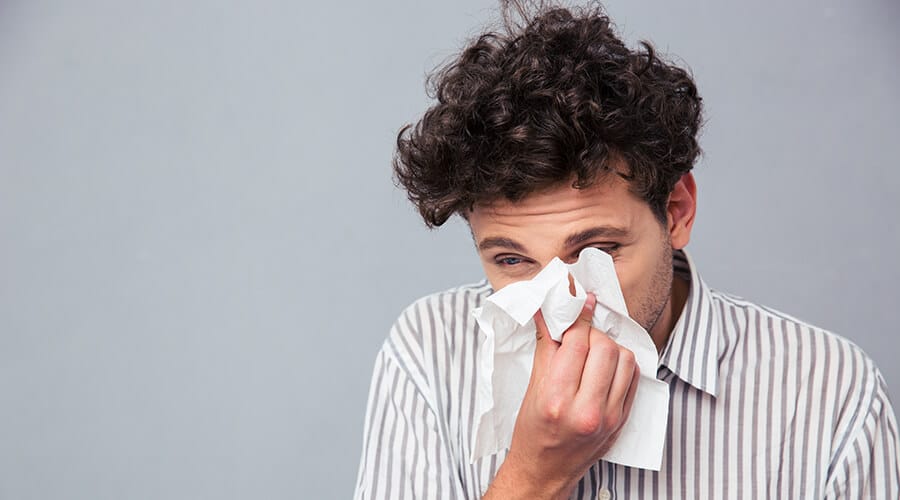We use tissue paper products every day without giving them much thought. But is tissue paper biodegradable or eco-friendly ?
I use colored tissue paper to wrap presents or line gift bags and facial tissue paper to blow my nose. It’s ubiquitous, inexpensive, and easy to find.
So are tissues biodegradable? If you’re eco-conscious, like me, you’ll be looking for every opportunity to reduce your carbon footprint. Read on to see what I discovered.
How many facial tissues have you gone through this year?
Multiply that number by the number of people using them and it can soon amount to a staggering amount of waste. A more sustainable option is to find products that biodegrade.
The amount of used tissues every year is massive, According to the U.S. Census data and Simmons National Consumer Survey (NHCS) the American public use approximately 8 boxes of tissues every 30 days!
Of course, the most eco-friendly tissue paper alternative is a handkerchief, but those have dropped out of popular use and have been replaced with more convenient, disposable alternatives.
KEY TAKEAWAYS
- We use tissue paper products every day, but many people don’t realize that it is biodegradable.
- Tissue paper is made from wood pulp, which is cut into chips and mixed with water to make pulp. It is then dried, cut into shapes, portioned, wrapped in a machine, and packed for distribution.
- Recycling tissue paper is not possible because the fibers are too short to be reused and it often contains chemicals or waxes that make it difficult to break down during the recycling process.
- The amount of used tissues every year creates a staggering amount of waste. However, tissue paper is biodegradable and there are ways to reduce your ecological footprint by composting it instead of throwing it away.

How Facial Tissues Are Made?
Generally, facial tissues are produced from pristine wood (although now most tissues are made from recycled products). It’s then cut into chips and sliced into tiny pieces for processing.
The tiny wood chips are mixed with large quantities of water to make pulp. Chemical additives like bleach can be used as a means of softening, strengthening, or coloring.
It is then pumped onto massive steam-heated containers for drying paper and then poured into heated rollers to dry.
The resulting material is cut into shapes, portioned, wrapped in a machine, and subsequently packed for distribution.
With the growing demand for tissue paper products worldwide, manufacturers are aiming as much as possible to meet demand at affordable costs.
From the tree to the storage process, tissue paper production requires energy-intensive, water-consuming processes involving chemicals.
For more eco friendly tissue paper look for bamboo facial tissue paper like these from Cheeky Panda.
Is It Possible To Recycle Tissue Paper?
With recycling, it can sometimes be hard to keep up with what can and can’t be recycled.
Tissues are one of those items that you might not think twice about throwing in the recycling bin, but is tissue paper recyclable?
In short, the answer is no – recycling tissue paper is not possible.
Tissue papers are made from wood pulp, which is a type of fiber. Once tissue paper has been used, the fibers are too short to be reused.
In addition, tissue paper is often coated with chemicals or waxes, which makes it difficult to break down during the recycling process.
Another issue with making tissue paper recyclable or not is that most times they are used for things that make it very unpleasant for recycling sorted to handle!
What Are Sustainable Alternatives to Tissue Paper?
Other than recycled / post-consumer tissue, there are many more sustainable and eco-friendly choices than standard paper tissue that can help reduce our environmental footprint.
- Reusable Cloth Handkerchiefs are an excellent option, as they can be washed regularly and used over and over again. See these organic cotton handkerchiefs.
- Bamboo Tissues like these from Cheeky Panda are another option. Bamboo is a fairly new entry to the organic tissue paper market. They are compostable but also require significantly less water to make than standard tissues.
- Hemp is one of a variety of plant-based materials that can be used instead of traditional tissue paper. Hemp fiber is incredibly durable as well as being gentler on the skin when used for facial cleansing or makeup removal.
Furthermore, many of these products now come in biodegradable packaging making them even better for the environment.

Is Tissue Paper Biodegradable?
Whether tissue paper is biodegradable depends on a few factors, including the type of tissue paper and how you dispose of it.
For example, if you throw away a Kleenex in your home garbage can, it will take much longer to decompose than if you compost it.
According to the Environmental Protection Agency (EPA), the average American generates about 4.9 pounds of waste each day.
Biodegradability is the process that occurs when microbes break material into smaller pieces. Those changes can be enhanced if oxygen or moisture is present.
In general, it takes anywhere from two weeks to four months for tissue paper to decompose.
However, this timeframe could be shorter or longer depending on the specific circumstances.
If you’re looking for ways to reduce your ecological footprint, there are a few things you can do with your tissue paper instead of just throwing it away:
- Reuse: You can reuse tissue paper that isn’t too dirty, you can use it more than once before tossing it in the trash.
Just be sure to store it in a clean, dry place so bacteria don’t have a chance to grow. - Compost Tissue Paper: Because tissue paper is biodegradable, composting is a great way to turn organic waste – like used tissue paper – into nutrient-rich food for your garden soil.
To make tissue paper compostable, just tear it into small pieces and add it to a compost pile or bin – like this kitchen compost bin on Amazon – along with other organic materials like food scraps and yard waste.
The tissue paper will also help soak excess water in your compost bin. Just be sure that it doesn’t contain any plastic or glitter.
Is Tissue Paper Eco-Friendly?
The answer may surprise you, but modern tissue paper is actually quite eco-friendly!
The majority of tissue papers on the market are made from recycled material, which means that it requires less energy and water to produce than traditional tissue paper.
Recycled tissue paper is also just as strong and durable as traditional tissue paper, so there’s no need to worry about sacrificing quality for the sake of being eco-friendly.
There are a few things to keep in mind if you’re looking for the most eco-friendly option possible.
- First, check to see if the tissue paper is made from 100% recycled materials. If it’s not, that doesn’t necessarily mean that it’s not eco-friendly, but it’s always best to choose recycled products whenever possible.
- Second, look for products with the least amount of packaging. Packaging for tissue papers is usually minimal, but some brands go overboard with unnecessary packaging materials – such as cellophane wrapping, etc.
Choose products with less packaging to further reduce your impact on the environment.
Is Tissue Paper Toxic?
Some traditional types of paper tissue are treated with bleach and other chemicals. The process of bleaching wood pulp can release harmful chemicals into the environment.
Bleach is used to brighten the color of tissue paper and make it whiter. Unfortunately, bleach is also a known pollutant that can damage ecosystems.
Dioxins and furans are byproducts of the bleaching process that can cause health problems.
The good news is that there are ways to make tissue papers without using bleach. Many brands use enzymes or peroxides instead of bleach to brighten the color of their tissue paper.
These alternative methods are much safer for the environment and for human health.
Additionally, many brands of eco-friendly tissue paper are made from recycled content like post-consumer waste (PCW).
If your brand of tissue paper is made with bleached wood pulp, then it may contain harmful chemicals.
However, there are many brands of eco-friendly tissue papers on the market that are made without bleaching and are safe for both the environment and your health.
When in doubt, check the labels!
Why Should We Use Biodegradable Tissue Paper?
If you’re looking for a more environmentally friendly option for tissue paper, then biodegradable tissue paper is a great choice. Here are just a few of the benefits:-
- Biodegradable tissue papers are usually made from recycled material: This means that it doesn’t require the felling of trees, which is great news for the environment.
- Tissue papers dissolve fast: Once you’re done with your tissue paper and ready to dispose of it, you’ll be happy to know that it will break down very fast. This is because the fibers in tissue paper are shorter, which makes them less durable and easier to break down.
- Composting tissue paper: If you have a compost pile, you can add your used tissue paper to it without worrying about harming the environment. The composting process will turn the tissue paper into nutrient-rich soil that can be used to grow plants.
Conclusion:
Making the switch to biodegradable, eco-friendly tissue paper is a great way to reduce the environmental factors affecting the planet.
Not only is it better for our ecosystem, but it’s also just as affordable as conventional tissue paper.
Look for options made from 100% recycled paper, and be sure to check for minimal packaging.
Making small changes like this can help make a big difference for the environment! So why not make the switch to biodegradable tissue today? Your nose (and the planet) will thank you!


